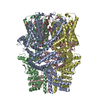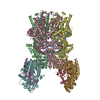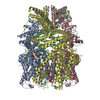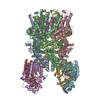+Search query
-Structure paper
| Title | Molecular architecture of the Gα-bound TRPC5 ion channel. |
|---|---|
| Journal, issue, pages | Nat Commun, Vol. 14, Issue 1, Page 2550, Year 2023 |
| Publish date | May 3, 2023 |
 Authors Authors | Jongdae Won / Jinsung Kim / Hyeongseop Jeong / Jinhyeong Kim / Shasha Feng / Byeongseok Jeong / Misun Kwak / Juyeon Ko / Wonpil Im / Insuk So / Hyung Ho Lee /   |
| PubMed Abstract | G-protein coupled receptors (GPCRs) and ion channels serve as key molecular switches through which extracellular stimuli are transformed into intracellular effects, and it has long been postulated ...G-protein coupled receptors (GPCRs) and ion channels serve as key molecular switches through which extracellular stimuli are transformed into intracellular effects, and it has long been postulated that ion channels are direct effector molecules of the alpha subunit of G-proteins (Gα). However, no complete structural evidence supporting the direct interaction between Gα and ion channels is available. Here, we present the cryo-electron microscopy structures of the human transient receptor potential canonical 5 (TRPC5)-Gα complexes with a 4:4 stoichiometry in lipid nanodiscs. Remarkably, Gα binds to the ankyrin repeat edge of TRPC5 ~ 50 Å away from the cell membrane. Electrophysiological analysis shows that Gα increases the sensitivity of TRPC5 to phosphatidylinositol 4,5-bisphosphate (PIP), thereby rendering TRPC5 more easily opened in the cell membrane, where the concentration of PIP is physiologically regulated. Our results demonstrate that ion channels are one of the direct effector molecules of Gα proteins triggered by GPCR activation-providing a structural framework for unraveling the crosstalk between two major classes of transmembrane proteins: GPCRs and ion channels. |
 External links External links |  Nat Commun / Nat Commun /  PubMed:37137991 / PubMed:37137991 /  PubMed Central PubMed Central |
| Methods | EM (single particle) |
| Resolution | 3.15 - 3.93 Å |
| Structure data | EMDB-33021, PDB-7x6c: EMDB-33022, PDB-7x6i: EMDB-34300, PDB-8gvw: EMDB-34301, PDB-8gvx: |
| Chemicals | 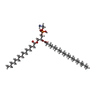 ChemComp-PTY:  ChemComp-POV:  ChemComp-Y01:  ChemComp-ZN:  ChemComp-CA:  ChemComp-YZY:  ChemComp-GTP: |
| Source |
|
 Keywords Keywords | METAL TRANSPORT / TRP /  transient receptor potential transient receptor potential |
 Movie
Movie Controller
Controller Structure viewers
Structure viewers About Yorodumi Papers
About Yorodumi Papers




